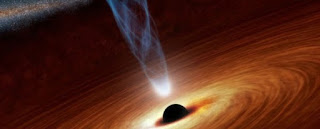Visible light emitted from a black hole has been detected for the first time
A black hole producing a light......
For the first time, astronomers have observed
bursts of visible light being released by a black
hole as it swallows matter from nearby stars.
These flashes of light, which lasted between
several minutes to a few hours, were seen
coming from a black hole in the Cygnus
constellation, located about 7,800 light-years
away from Earth. Incredibly, some of the
flashes were so bright, the team says amateur
astronomers could see them with a modest 20-
cm telescope.
"We find that activity in the vicinity of a black
hole can be observed in optical light at low
luminosity for the first time," astronomer and
lead researcher, Mariko Kimura from Kyoto
University in Japan, told Charles Q. Choi at
Space.com .
"These findings suggest that we can study
physical phenomena that occur in the vicinity
of the black hole using moderate optical
telescopes without high-spec X-ray or gamma-
ray telescopes."
Nothing - including light - can escape a black
hole once it’s fallen in, but the process of
swallowing gas, dust, or ripping apart whole
stars can cause the formation of an accretion
disk near the event horizon. These disks can
thrust streams of plasma called relativistic jets
across the entire length of a galaxy, while
hitting temperatures of 10 million degrees
Celsius (18 million degrees Fahrenheit) or
more.
This insane heat can cause a black hole
accretion disk to give off an incredibly bright
glow, which is what Kimura and her team
observed when they focussed in on V404 Cygni
- an active black hole in the Cygnus
constellation that reactivated on 15 June 2015
after 26 years of dormancy.
First detected by NASA's Swift space
telescope, the event was then tracked by the
Japanese researchers, who called on scientists
from 26 locations around the world to point
their optical telescopes at V404 Cygni.
For two weeks, the astronomers were able to
observe flashes of light being released by the
newly active V404 Cygni, which is one of the
closest known black holes to Earth. It was
woken up when the gravitational pull of its
partner star pulled the two in too close,
causing the black hole to strip away the
surface matter of the star, before the whole
thing fell in to release an incredible burst of
radiation.
For the first time, astronomers have witnessed
the light produced by this event using an
optical telescope.
Publishing in Nature today , the team
hypothesises that the light originates from X-
rays produced in the centre of the accretion
disk, and these X-rays irradiate and heat up the
outer region of the disk, which causes it to
emit optical rays.
While more research is needed to confirm this,
it’s beyond exciting to think of how much more
we stand to learn about black holes now that
we have a new way of observing them - and
it’s something anyone can help with if they
have a good telescope at home.
"We're very pleased that our international
observation network was able to come together
to document this rare event," said co-author,
Daisuku Nogami.



Comments
Post a Comment